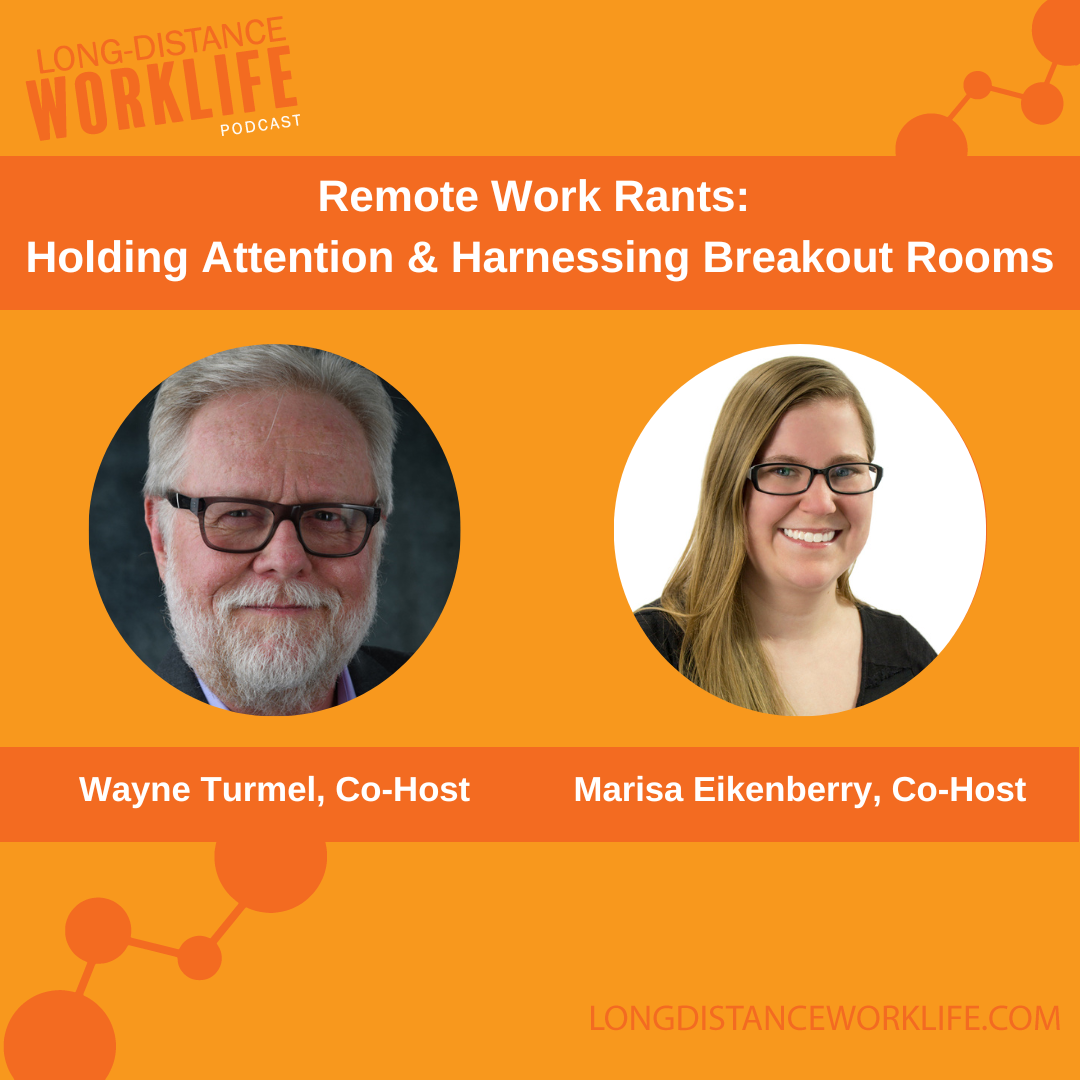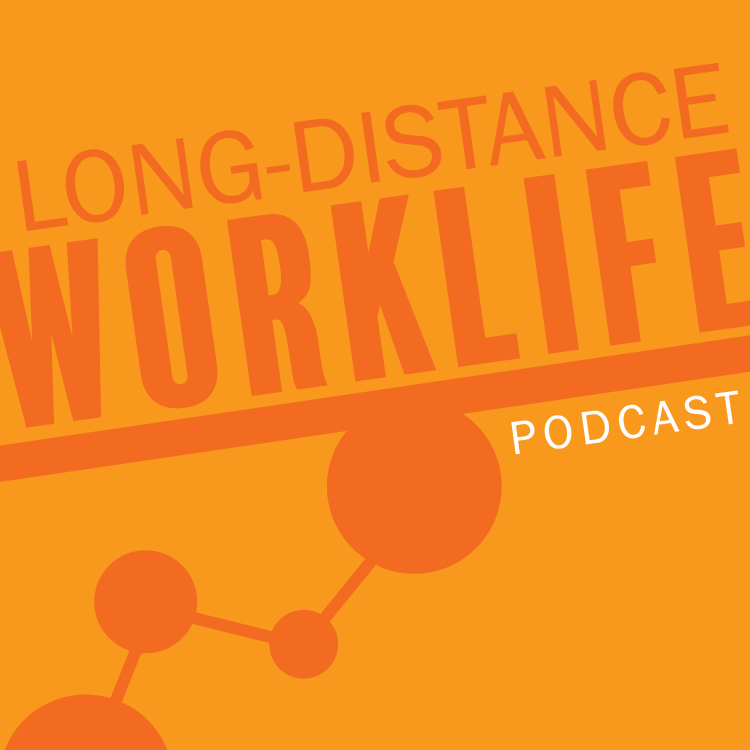Pilar Orti, founder and director of Virtual Not Distant, meets with Wayne to discuss tips for new managers on a remote team, having conversations around how to use tools effectively, thinking about "remote-first", and how silence doesn't necessarily mean things are okay.
Virtual Not Distant works with leaders, managers, and HR professionals to create a "remote-first" environment whether you're planning to stay remote or becoming a hybrid organization.
Question of the Week:
What is one pitfall that managers need to be aware of?
Additional Resources:
Transcript
Wayne Turmel: Hi, everybody. Welcome to the Long-Distance Worklife, the podcast where we talk about remote work, technology, leadership, and generally just navigating and surviving this crazy world of virtual and hybrid work. My name is Wayne Turmel. Marisa will not be joining us today because I have an interview with a very smart person named Pilar Orti. Pilar is the founder and director of Virtual Not Distant.
Most of her work is done in England and the European Union and I think she brings a really interesting perspective to remote work. And so I wanted you to experience that. Of course, you know the drill. Listen up, take good notes. We will, of course, capture and transcribe that in our show notes. And for right now, I want you to enjoy the conversation with Pilar Orti.
I am really excited today to be with Pilar Orti. Our trails have crossed a couple of times over the last couple of years. She does really good work. Her company is VirtualNotDistant.com, of which she is the founder and director. Really quick, Pilar. What do you guys do?
Pilar Orti: Well, mainly we help managers of remote teams through either training or by providing a listening ear sometimes. And we have the 21st Century Work Life Podcast, which aims to support anyone who is interested in leading teams and working online.
Wayne: So obviously she's a direct competitor and must be destroyed, but she does really good work is the point. And I wanted to introduce all of you to her because you cannot have enough smart people in your orbit. Pilar, you've been in this space a long time. Let me ask you this. When a manager is taking on a new position, especially if there's a remote component and they have never done that before.
What kind of is Job One? What is the first thing that they need to do?
Pilar: I've actually got two answers to that. So I think that there's always two elements for me in leading a team. One is what we do as individuals and how we connect to the team members individually. And the other one is how we look after the team and how we support the team to continue all the time building that team and and supporting them.
So I think that the first thing when we are new, either we might even be in our team and become the team leader or we might come in for a new team is to communicate our availability and how we communicate, how available we are to people because especially we are remote, we sometimes we assume that if we say, "Oh, I'm available all the time," that people are going to look for us when they need us.
And actually there's when you can't see whether someone is busy, working, etc. you more reluctant normally to interrupt them.
Wayne: I think that's a really, really important point, which is one of the things that the people on the team struggle with is I don't want to bug the boss I don't want to bother them. And what that means is the manager is saying, "Hey, I've got an open door policy, come talk to me" and nobody's coming to talk to me.
So I think that's a really interesting point.
Pilar: And the equivalent of having an open door policy as well could be if setting hours, setting open door hours during which you sit behind your computer. If you're if you're at that time and you open a meeting and everyone has the link to that meeting, are you just there? And people can literally drop in? That's one, one thing that you could do.
So communicating availability. And the other thing I think is to be aware of and this takes a bit more time, is to be aware of the team's rhythm of communication and how that fits with the tasks we're doing and the need to connect. So, for example, our experience working remotely might be of being in a team where everyone pretty much gets on with their work because that's the best way of doing it.
And suddenly we might land in a team who are used to being available a lot, sending lots of messages backwards and forwards during the day. So it's this awareness and then making sure that that rhythm fits the task and also the need for connection. So one is something very immediate, and I think looking at the team takes a little bit more time.
Wayne: There's two things that you said there. One is the idea of creating office hours, for lack of a better term.
Pilar: Yeah.
Wayne: Where regardless of where you are in the world, you know that at this time it's okay to bug your manager.
Pilar: Yes.
Wayne: And I think that's a really simple and yet effective tool. The second thing is this idea of the rhythm that the team works. Generally speaking, we are not starting from a blank sheet of paper, right? That the team already exists, the boat is in the water and we need to adjust to it.
What is what are some of the things that managers bump their nose against when they take over an existing team like that?
Pilar: I think it's sometimes it's an assumption that we are using technology in the same way. So it could be that. And if we are a remote team, we're using technology to communicate. So it could be that we use a platform that we've used before, but we're used to using it in a certain way and the team is using it in another one.
And not having that conversation at the beginning of how we're going to use the technology. I think this can be one of the biggest things and one of the biggest differences assuming back to that.
Wayne: We'll come back to that question for those of you listening. The reason Pilar stopped talking is because I got this look on my face and she realized my head was about to explode. Um, I want to talk about that notion of using tools differently because you work with teams and primarily you're on the eastern side of the Atlantic with your clients, with tools like Microsoft Teams, like Slack, with these kinds of tools.
What are you seeing in terms of how well people use them and actually do what the darn things can do.
Pilar: Yeah.
So there's there's lots of things. And I think that we cannot ignore the pandemic, which meant that everyone started using the the tools.
Wayne: Well, and also, yeah, Microsoft threw Teams out in the world two years too early.
Pilar: Yeah.
Wayne: Isn't this a-
Pilar: Good.
Wayne: Win?
Pilar: Yes. Yeah. Yeah. That it is also true that when you go for it and very interestingly. So I started using Teams with a client before the pandemic and we rarely met on it on Teams. We used it mainly for asynchronous communication. We used all the other tools. So I think that one of the things that we're seeing is that tools that can be used for asynchronous communication, like Teams are only being used in the video function and they're being used mainly to communicate in real time.
So I think that that is the main thing I'm seeing is that there's not the tools haven't been embraced as a space to give us a bit more breathing space and to be able to communicate in a slower pace. And so that being used to communicate quite rapidly as though we were in the office next to each other.
Wayne: I'm glad you went there because this is actually a question that I've been struggling with and why I'm looking to very smart people who can look at this. A lot of what we're dealing with it seems to me too many meetings, too much email, all of that is because we're trying to recreate the office environment.
Pilar: Yeah.
Wayne: And as especially as we start to think about return to the office, and most of that is going to be some hybrid mix.
Pilar: Hmm.
Wayne: Right. People in the office and people not. And some people in on Tuesdays and not on Wednesdays. What what do we need to think about differently instead of just trying to recreate the office or worse going back to defaulting to the office?
Pilar: Yeah.
Wayne: Right? Where everything, you know, the sun revolves around the Statue of Liberty. And so everything has to be done on New York time regardless.
Pilar: Yeah. Yeah.
Wayne: What does this new as we're thinking about creating something new, what needs to be new and different?
Pilar: I think I'll start with two things. One, which leads from the use of tools that we were just talking about. So we need to have some kind of conversation. And this is very difficult because we need to have some conversation about how are we going to communicate. And this means maybe setting some agreements and we might not be used to this because communication, why do we need to, to, to set so many parameters?
But for example, if you look at how email has been used, some people use it as almost instant message. Some people think it's okay to wait three days to reply to an email. Some people are like, "Why didn't you reply to my email that I sent 2 hours ago?" Because email was introduced without having a conversation around it in most organizations.
And so now everyone uses it differently and sometimes it causes some chaos. So some stress, rather. So I think that first of all, is we need to talk about how we are using these tools and have some agreement, some parameters. Even if it sounds easy and even if it sounds like we are removing all spontaneity from human contact, we need that.
And then the other thing specifically to hybrid work, which involves maybe some people being in the office, others not or people using the office at different times, is that if we think of hybrid as a subset of remote, it means that essentially the office becomes one more tool, one more space where we do the work it becomes one more place where we communicate because we also have the video tools.
We also have asynchronous platforms and if we think about it like that, then we have a chance of creating some kind of cohesive way of working rather than ending up where, well, if you're in the office, you work like this. If you're online, you work like this. Lots of us are in the office all the time, so we work in this way.
A lot of us are remote all the time, so we work in that way. So I think that mindset of hybrid is a subset of remote, because in the end, the space that is common to every knowledge worker is not the office, it's the online space regardless of where you are. So initially that mindset shift and then the practicalities, of course, that are harder.
Also, you know, nothing is easy, but you need that mindset initially rather than thinking, well, we are office based and some people work from home some time.
Wayne: And wow, I'm really glad that you stated that so succinctly that the default is no longer in the office. Right. It used to be in the before time's the blessed before times when most people were in the office and we let some people work from home. And so basically the office is how this works. And now the default is the kind of cyber space as opposed to the office.
And that changes how we meet when we meet and yeah, who works on things and. Yeah. And like that. The second thing you said, by the way, and I don't think there are enough icky conversations, icky being the highly technical term for slightly uncomfortable and weird and I don't know why they're uncomfortable. Over 70% of our workplace communication happens in writing.
People that have been listening to this podcast are already tired of me saying that my business career ties perfectly to the intro from the introduction of email to wherever we are now. So I've watched this thing occur. Well, if there is something that we spend 70% of our time doing and it's already existed when most people are in the workplace, why do we not talk about it?
Like, how can we not give people better training how do we not have the conversations about when do we use what? And no, you know, when you're on your eighth thing in an email thread, pick up the phone.
Pilar: Yes.
And I think it's because it's assumed that, of course, everyone knows how to do it. This is one of the resistances I used to get and maybe but everyone has preferences and everyone has a legacy from another time and everyone and everyone thinks that something is the common sense to do. I think maybe that said is that it is common sense, but our way of saying common sense is different.
So we need to agree, agree on that. And especially as you were mentioning earlier, especially if there are different cultures than our points of reference, we're working across the globe. Our points of reference are going to be different as well because we've grown up in different contexts we've worked in different contexts. So we can't really assume that we all think that common sense means the same thing.
Wayne: Wow. That is absolutely true. So, okay, we are almost at the end of our time because I knew that this would happen and- One pitfall that managers should be wary of. Just what if you could give one warning if you could yell out, stop to the managers out there, what is one thing that you think they need to be aware of today's warning.
Pilar: I would say that don't assume that silence means everything's okay.
So I'll leave it at that and everyone can. Can I leave it at that?
Wayne: No, it's absolutely true. I mean, there are a couple of things associated with that. One is we tend to, as managers, default to spending most of our time on our problem children. And so we assume that if we don't hear anything, no news is good news. And that creates some interesting dynamics changes. But the other thing and it goes back to setting those office hours or making yourself available as people are not as willing to be proactive about reaching out as they could or should be.
Pilar: Yeah. And in the end, all you all some people need is how is everything going? That's all they need. And then they'll open up. But actually, they might not think that the time is ever right to bring anything up if they don't ask. So I think that's especially when you're working at a distance with different kinds of people.
I think that the interpretation of silence you've got to be very careful with.
Wayne: And the way you ask that question, how's everything going is very different question than is everything okay?
Pilar: Oh, yeah. Yes. Because is everywhere. Is everything okay? It's really easy to answer regardless. It's very difficult well, it's very difficult sometimes to say no. You know, it is there with you. No, it isn't. Yeah. Yeah.
Wayne: Excellent. Thank you so much, Pilar Orti who is the founder and director of Virtual Not Distant. So good to talk to you again. Lovely to talk to you. And thank you for being on the Long-Distance Worklife.
Pilar: Thank you very much.
Wayne: Thank you so much for joining us on the Long-Distance Worklife today. I trust that you enjoyed that conversation. You will find links to Virtual Not Distant and Pilar's work on our show notes. Those, of course, are on longdistanceworklife.com. Join us next week when I will be joined by Marisa. We will be doing one of our Q&A issues.
We really, really want your questions and your comments to guide where our conversations go. So please visit longdistanceworklife.com. Drop us a comment. You know, if you listen to podcasts that it's really important that you like and subscribe so other people can find us. Thank you so much for joining us. We hope that we are helping keep the weasels at bay and we will see you next episode.
Thanks so much.



